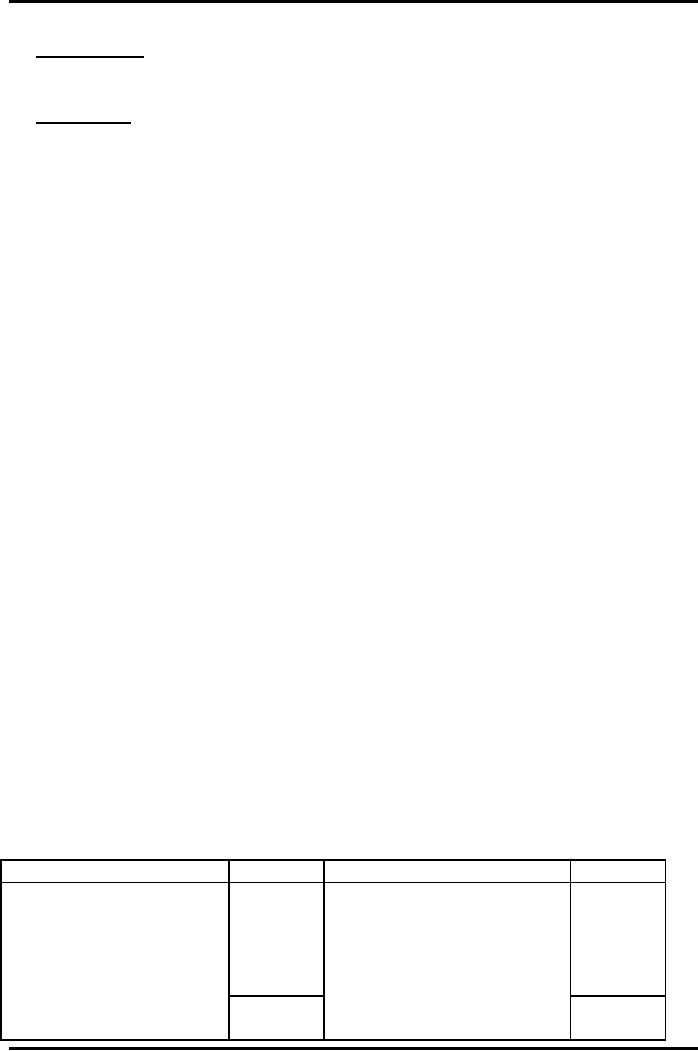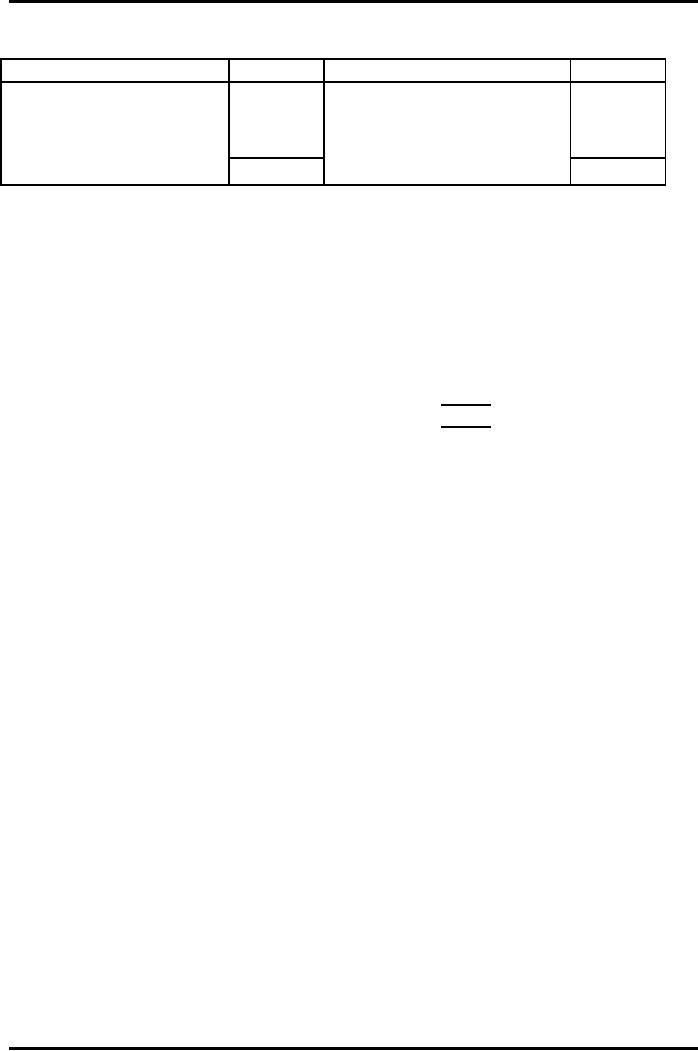 |
BRANCH ACCOUNTING |
| << BRANCH ACCOUNTING SYSTEMS |
| BRANCH ACCOUNTING - STOCK AND DEBTOR SYSTEM >> |

Advance
Financial Accounting
(FIN-611)
VU
LESSON
#12
BRANCH
ACCOUNTING
Pro-forma
Invoice Price
Head
office may send goods to
branch either at "cost" or at
"pro-forma invoice
price".
In
previous section of this
chapter we have discussed
accounting treatment for a
dependent
branch to which the goods
are sent to branch at cost
price. In the
forthcoming
section we will discuss the
accounting treatment for the
dependent
branch
to which goods are sent at
pro-forma invoice price. The
treatment is slightly
different
but before discussing the
accounting treatment we must know what
pro-
forma
invoice price is and why head
office prefers to send goods
at pro-forma invoice
price.
Pro-forma
invoice price is higher than
the cost price. Adding a
reasonable profit in
the
cost
makes the price equal to
the pro-forma invoice price.
Here we must know what is
selling
price? Selling price is the
price at which goods are
sold to the customers. So
the
selling
price will be higher than the
pro-forma invoice price in normal
circumstances.
Difference
between cost and pro-forma
invoice price is known as loading and
the
difference
between cost and the selling
price is the profit in real
terms.
Head
office usually sends goods to
its branches at the
pro-forma invoice price to
keep
its
profit margin secret from
the branch managers. Had the
cost been known to
the
branch
manager he would have been in a
position to determine the
exact profits
enjoyed
by the head office, which may
induce the branch manager to
confront the
business
as a competitor. Moreover by sending
goods to the branches at
pro-forma
invoice
price, the head office
can dictate pricing policy
to its branches, as well as
save
work at
the branch because prices
have already been decided.
Sending goods at pro-
forma
invoice price is generally
done where goods are of
standard type,
pre-packed
and unlikely to
fluctuate in price.
Here
it is worth mentioning that "pro-forma
invoice" is name of the
document which
is
sent to branches along with
the goods sent; in this
document description and
quantity
of the goods sent is written
along with the price.
Therefore the price
appearing
on the pro-forma invoice is
named as pro-forma invoice
price.
The
document which is sent to the
customers to evident the
sales of goods to them is
known as
"invoice"; this document
discloses the quantity,
description and selling
price
of the goods sold, along
with the settlement terms.
Technically speaking
"selling
price"
may also be termed as "invoice
price", but "invoice price" and
"pro-forma
invoice
price" are different. It is a
common error that often
people do not care while
using
the terminology and confuse
"invoice price" with the
"pro-forma invoice
price".
The
method of preparing Branch a/c while
goods are sent at pro-forma
invoice price is
the
same with the exception that
the accounting entries
relating to the goods sent
to
and
goods returned from the
branch are recorded at
pro-forma invoice price and
a
reverse
adjustment is required with the amount of
loading (difference between
cost
and
pro-forma invoice
price).
Remember;
the accounting entries for
opening and closing stocks
are recorded at cost
price.
Do not record stocks at pro-forma
invoice price.
Rationale;
an accountant is supposed to record
accounting entries evidenced by
a
source
document. Goods sent to
branch are evidenced through
"pro-forma invoice"
therefore
price mentioned on the
document cannot me ignored while
recording this
56

Advance
Financial Accounting
(FIN-611)
VU
transaction.
Whereas, valuation of opening and
closing stocks is not reported
through
pro-forma
invoice therefore to make it
simple stocks are accounted
for at cost.
Accounting
Entries in the Books of Head
Office
11.
For opening balances of assets at the
branch
Branch
a/c
Branch
assets a/c (individual accounts)
12.
For opening balances of liabilities at
the branch
Branch
liabilities a/c (individual
accounts)
Branch
a/c
13.
For goods sent to the branch
(at pro-forma invoice
price)
Branch
a/c
Goods
sent to branch a/c
14.
For return of goods by the
branch (at pro-forma invoice
price)
Goods
sent to branch a/c
Branch
a/c
15.
For reversal of loading on (net)
goods set to branch (with
the amount of loading)
Goods
sent to branch a/c
Branch
a/c
16.
For remittance of cash or
cheque to the branch
Branch
a/c
Cash/Bank
a/c
17.
For cash or cheque received
from the branch
Cash/Bank
a/c
Branch
a/c
18.
For closing balances of assets at the
branch
Branch
asset a/c (individual
accounts)
Branch
a/c
19.
For closing balances of liabilities at
the branch
Branch
a/c
Branch
liabilities a/c (individual
accounts)
20.
For closing goods sent to branch
account.
Goods
sent to branch a/c
Purchases
a/c
57

Advance
Financial Accounting
(FIN-611)
VU
21.
For closing branch account
into the profit and loss
account
Incase
of profit
Branch
a/c
Profit
& loss a/c
Incase
of loss
Profit
& loss a/c
Branch
a/c
22.
For abnormal loss (should
always be accounted for at
cost)
Abnormal
loss a/c
(at
cost)
Branch
a/c
Insurance
claim a/c (claim
admitted)
Profit
& loss a/c
(balance
if not admitted by the insurance
company)
Abnormal
loss a/c (cost of the
abnormal loss)
Note:
No accounting entry is required for normal
losses.
Solved
Problem # 1
Excellent
Garments of Multan has a branch at
Lahore. Goods are supplied
to the
branch
at cost. The expenses of the
branch are paid from Multan and
the branch keeps
a
sales journal and the
debtors' ledger only. From
the following information
supplied
by
the branch, prepare a Branch
Account in the books of the
head office. Goods
are
sent
to branch at pro-forma invoice
price which is cost plus 20%. (All
figures in
rupees)
Opening
Stock (at Pro-forma invoice)
28,800 Closing Debtors
9,150
Closing
Stock (at Pro-forma
invoice)
21,600
Opening Debtors
?
Goods
received from HO (at Pro-forma
invoice)
40,320
Bad
Debt
140
Credit
Sales
41,000
Expenses
paid by Head office
10,400
Cash
Sales
17,500
Cash
received from Debtors
37,900
Pilferage
of goods by the employees (Normal
Loss) 2,000
Solution:
(Debtors System)
In
the books of Head Office
(Multan)
Lahore
Branch Account
Particulars
Rs.
Particulars
Rs.
Opening
Stock
24,000
Cash
Received from Branch
17,500
Opening
Debtors
6,200
Cash
Received from Debtors
37,900
Cash
sent to Branch
10,400
Goods
sent to Branch
6,720
Goods
sent to Branch a/c 40,320
(loading)
18,000
General
Profit & Loss a/c 8,360
Closing
Stock
9,160
(Profit)
Closing
Debtors
89,280
89,280
58

Advance
Financial Accounting
(FIN-611)
VU
Working:
Debtors
Account
Particulars
Rs.
Particulars
Rs.
Op.
Debtors (Balancing
6,200
Cash
Received from Debtors
37,900
fig)
41,000
Bad
Debts
140
Sales
(credit)
Cl.
Debtors c/f
9,160
47,200
47,200
Opening
stock at cost
28,800 x
100/120 = 24,000
(pro-forma
invoice x
% of
cost by
% of
pro-forma invoice)
Closing
stock at cost
21,600 x
100/120 = 18,000
(pro-forma
invoice x
% of
cost by
% of
pro-forma invoice)
Loading
on goods sent to branch
(net)
Rupees
Goods
sent to branch (at pro-forma
invoice)
40,320
Less
Goods returned by branch (at
pro-forma invoice)
0
Net
goods sent
(at
pro-forma invoice)
40,320
40,320 x
20/120 = 6,720
(pro-forma
invoice x
% of
loading by
% of
pro-forma invoice)
Income
Statement System
The
head office may also prepare
an Income Statement to find out the
profits of
branch.
Such Income Statement is
merely a memorandum; the only
reason for
preparing
the statement is to have full
information of all transactions which
are
ignored
in Debtor System (already
discussed in the previous
section). While preparing
the
Income Statement of the
branch we shall be using all
those skills which we
have
learned
in the single entry system of
accounting during conversion of single
entry into
double
entry.
We know very
well that in Income Statement
incomes and expenses are
measured on
the
basis of accrual concept and
the profits are measured
according to the
matching
concept.
So the cost of goods sold
will be determined keeping in view that
the goods
sent
to branch are equivalent to
purchases of the branch and
should be included at
cost.
Obviously the opening and
closing stocks can not be
measured at a value that
is
above
its cost.
Above
problem can be solved through
Income Statement System as well.
Following is
the
solution.
59
Table of Contents:
- ACCOUNTING FOR INCOMPLETE RECORDS
- PRACTICING ACCOUNTING FOR INCOMPLETE RECORDS
- CONVERSION OF SINGLE ENTRY IN DOUBLE ENTRY ACCOUNTING SYSTEM
- SINGLE ENTRY CALCULATION OF MISSING INFORMATION
- SINGLE ENTRY CALCULATION OF MARKUP AND MARGIN
- ACCOUNTING SYSTEM IN NON-PROFIT ORGANIZATIONS
- NON-PROFIT ORGANIZATIONS
- PREPARATION OF FINANCIAL STATEMENTS OF NON-PROFIT ORGANIZATIONS FROM INCOMPLETE RECORDS
- DEPARTMENTAL ACCOUNTS 1
- DEPARTMENTAL ACCOUNTS 2
- BRANCH ACCOUNTING SYSTEMS
- BRANCH ACCOUNTING
- BRANCH ACCOUNTING - STOCK AND DEBTOR SYSTEM
- STOCK AND DEBTORS SYSTEM
- INDEPENDENT BRANCH
- BRANCH ACCOUNTING 1
- BRANCH ACCOUNTING 2
- ESSENTIALS OF PARTNERSHIP
- Partnership Accounts Changes in partnership firm
- COMPANY ACCOUNTS 1
- COMPANY ACCOUNTS 2
- Problems Solving
- COMPANY ACCOUNTS
- RETURNS ON FINANCIAL SOURCES
- IASB’S FRAMEWORK
- ELEMENTS OF FINANCIAL STATEMENTS
- EVENTS AFTER THE BALANCE SHEET DATE
- PROVISIONS, CONTINGENT LIABILITIES AND CONTINGENT ASSETS
- ACCOUNTING POLICIES, CHANGES IN ACCOUNTING ESTIMATES AND ERRORS 1
- ACCOUNTING POLICIES, CHANGES IN ACCOUNTING ESTIMATES AND ERRORS 2
- BORROWING COST
- EXCESS OF THE CARRYING AMOUNT OF THE QUALIFYING ASSET OVER RECOVERABLE AMOUNT
- EARNINGS PER SHARE
- Earnings per Share
- DILUTED EARNINGS PER SHARE
- GROUP ACCOUNTS
- Pre-acquisition Reserves
- GROUP ACCOUNTS: Minority Interest
- GROUP ACCOUNTS: Inter Company Trading (P to S)
- GROUP ACCOUNTS: Fair Value Adjustments
- GROUP ACCOUNTS: Pre-acquistion Profits, Dividends
- GROUP ACCOUNTS: Profit & Loss
- GROUP ACCOUNTS: Minority Interest, Inter Co.
- GROUP ACCOUNTS: Inter Co. Trading (when there is unrealized profit)
- Comprehensive Workings in Group Accounts Consolidated Balance Sheet